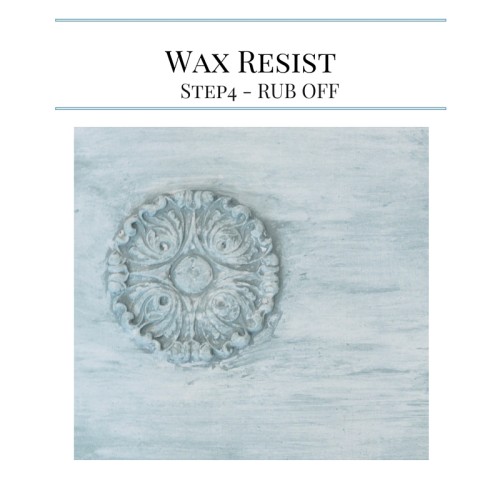Water and Oil Don’t Mix – Wax Resist
Every fifth grade art class teaches students that wax and water colors don’t mix. But… if you tell a five year old to use wax before painting furniture or walls they would look at you with that “you’re silly mummy” look that only a five year old can muster.
In this chapter of making patina we take advantage of this fact to give us one of the easiest painting techniques we know. Wax resist has been around for ages and is also used on fabric. The great indigo prints from 18th century France were all made with a wax resist on fabric using indigo dye.
We love this technique because it’s easy to control: not quite as messy as crud and a little more predictable than hemp oil.
Annie Sloan shows an excellent example in her book Color Recipes For Painted Furniture, so we decided to share in detail.
Speaking of Annie Sloan – the person not just the paint – she is all about figuring out “how-to” without the fuss. Her method of painting is to get a project done with the least amount of time for the best results. The wax resist method of aging and developing patina achieves this goal.
Did I mention it’s super easy to do on a large scale, like this bed Annie herself did.
Or this wall or this large bookcase and mirror. Last summer my friend Amy Chalmers and I did the bookcases and mirror using this technique. Photo by the divine Matthew Mead.

Step 1 – Pick your two colors and paint your base coat. As a general guideline use the color you want to dominate as your base coat. Paint one or two coats and let dry thoroughly. You can just clean a wooden surface and apply the wax if you want your wooden surface to show through, but you still need to thoroughly clean the surface first.
Some color combos we love are: Old White and French Linen Chalk Paint ® or Louis Blue and Aubusson used in our sample boards
Step 2 – When the base is dry, take your wax and apply it thickly using a damp cloth. (I know we’ve spent years saying don’t use too much wax, but now we’re saying glob it on!)

Rub the surface with the wax. If you’re working on a big piece of furniture or a flat wall, work in sections. Remember, the more you rub in the wax the less it will resist.
Step 3 – While the wax is still wet, apply a diluted layer of the second color of paint. You will see the wax resist the water in the paint. You need to do this while the wax is still wet, and not fully cured.
 Especially with Chalk Paint, if you rub back the wax and let it cure the paint will adhere to the surface with out chipping. To dilute the second coat of paint mix approximately 1/3 water to 2/3 paint. The more water, the more resist and the more the base coat will show through.
Especially with Chalk Paint, if you rub back the wax and let it cure the paint will adhere to the surface with out chipping. To dilute the second coat of paint mix approximately 1/3 water to 2/3 paint. The more water, the more resist and the more the base coat will show through.

Step 4 – Use a damp rag to rub off the excess wax and the second coat of paint will come with the wax, revealing your base coat underneath.
Once you’ve rubbed down the second coat – going with the grain of the wood – let it dry. If you get a hard line, as you may when working with large surfaces, just grab a damp rag and rub/wipe it to blend the line out.

See how the Louis blue base coat comes through with just hint of the Aubusson.

For the final step, finish with the top coat of your choice.
That’s it for resist methods. Next we’re going to look at layering techniques to create shadows and highlights.
Ciao until then

